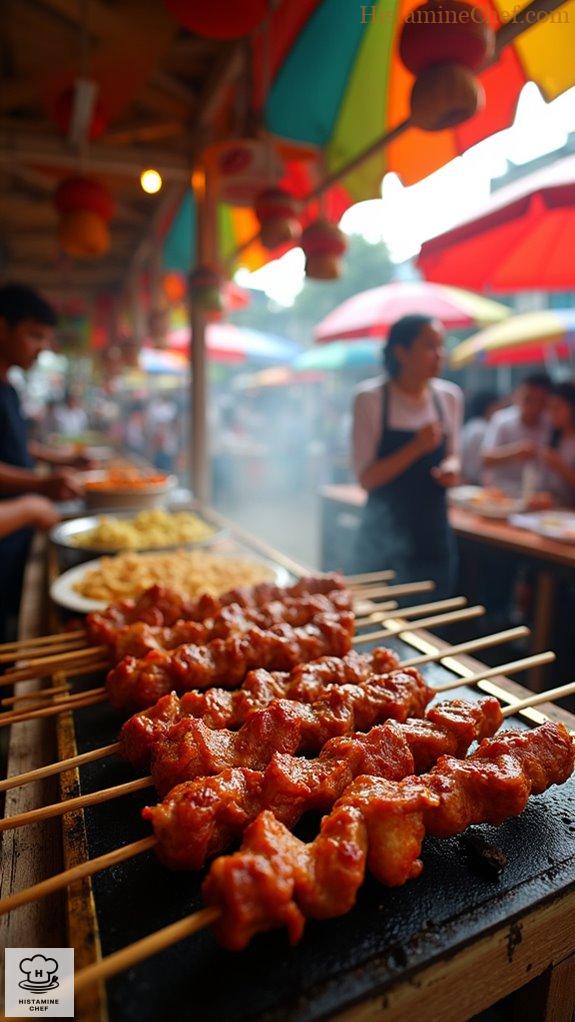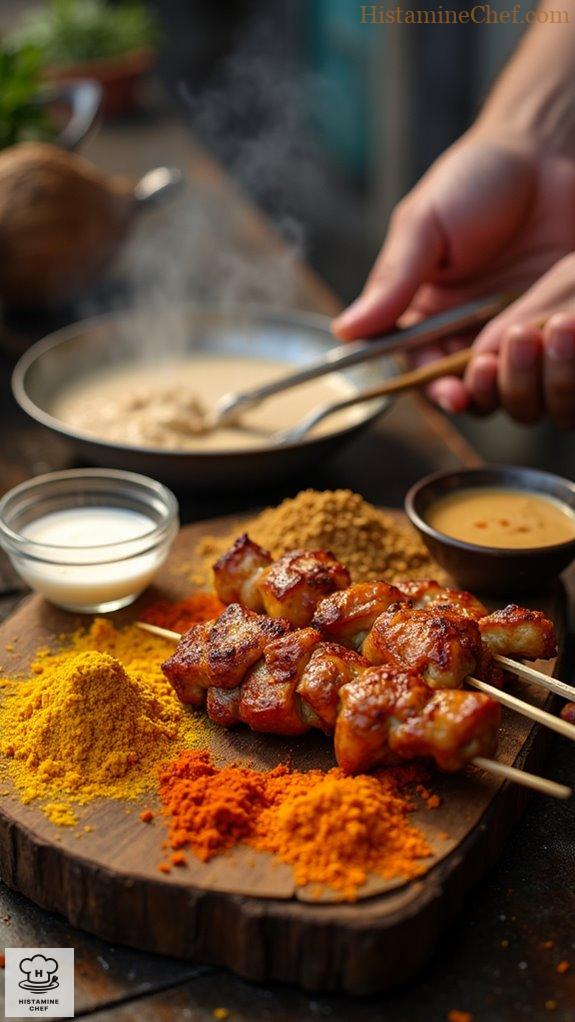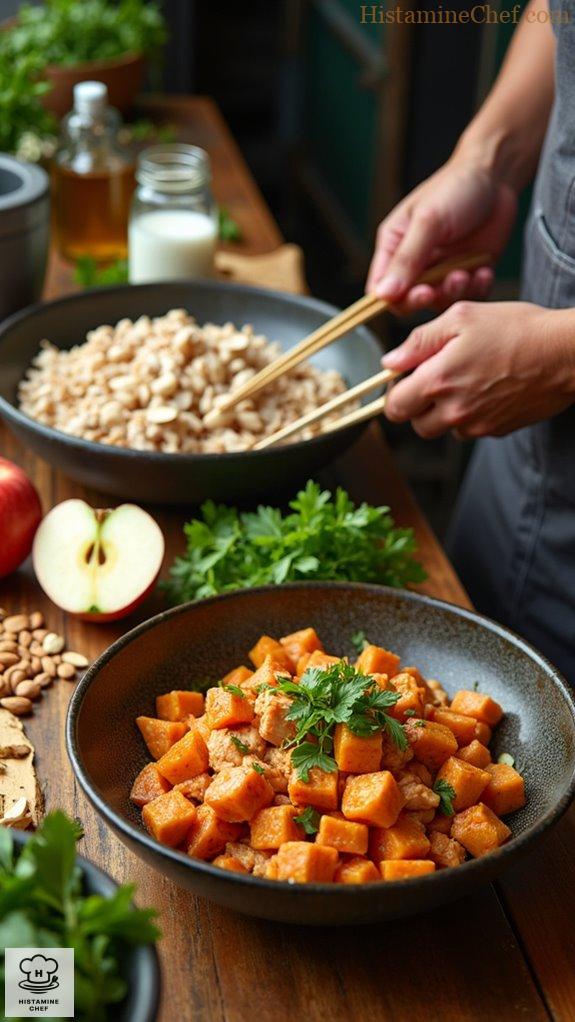Want to whip up some Malaysian satay that’s low in histamine? First, grab fresh chicken or turkey and marinate it in coconut milk with spices like turmeric and cumin—trust me, the flavors explode! Soak your bamboo skewers to keep them from burning while grilling over charcoal for that authentic smoky taste. Swap soy sauce with distilled vinegar for a zing! Pair it with sunflower seed butter sauce and fresh veggies, and you’re ready to impress. Ready for more tips?
Food Sanctuary of Southeast Asia

Street food in Malaysia, a vibrant part of the Southeast Asian culinary scene, reflects the nation’s rich tapestry of cultures and traditions. Since the early days of trade along its bustling ports, Malaysia has embraced diverse influences from Chinese, Indian, and Malay cuisines, creating a unique gastronomic identity.
The illustrious history of street food can be traced back to its roots in local markets, where vendors would serve up quick and affordable meals, allowing families to enjoy flavorsome dishes without much fuss.
Satay, one of Malaysia’s most famous street foods, showcases skewered and grilled meats marinated in a blend of spices, served with a delicious peanut sauce.
Over the years, street food has evolved, becoming a social experience where friends and families gather in night markets to savor local delicacies, exchanging stories and memories over shared plates.
Today, satay stands are found in every corner, embodying the essence of Malaysian hospitality and culinary creativity, offering not just food, but a connection to the country’s vibrant cultural heritage.
Charred Over Open Flames

Street vendors cook Malaysian Satay by marinating skewered pieces of meat, usually chicken or beef, in a blend of aromatic spices and coconut milk.
Once marinated, the skewers are placed over a hot charcoal grill, allowing the meat to receive a smoky flavor while achieving a perfect char on the outside. Vendors continuously baste the skewers with a mix of oil and spices to keep them moist and enhance flavor.
The intense heat from the open flames guarantees a tender interior while maintaining a beautifully caramelized exterior, showcasing the vibrant colors of the marinade.
Ingredients:
- Chicken or beef (500g, cubed)
- Coconut milk (200ml)
- Turmeric powder (1 teaspoon)
- Cumin powder (1 teaspoon)
- Brown sugar (2 tablespoons)
- Salt (1 teaspoon)
- Skewers (wooden or metal)
- Peanut sauce (for dipping)
Cooking Steps:
- Marinate meat with spices.
- Soak skewers in water.
- Thread meat onto skewers.
- Heat charcoal grill until hot.
- Place skewers on grill.
- Baste with oil mix.
- Cook until charred properly.
- Serve with peanut sauce.
Grill Marinated Skewers Directly

To make Malaysian Satay at home, start by marinating your choice of allowed meat such as chicken or beef for several hours or overnight in a mixture of coconut milk, minced garlic, and ginger.
Thread the marinated meat onto skewers, which can be soaked in water to prevent burning on the grill.
Preheat your grill to medium-high heat and cook the skewers for about 10-15 minutes, turning occasionally until the meat is cooked through and slightly charred.
For added flavor, serve with a dipping sauce made from pureed peanuts (confirm no restricted ingredients are used) or simply enjoy with a side of fresh cucumber and onion slices.
- Marinate chicken or beef in coconut milk
- Use wooden skewers, soak in water
- Grill on medium-high heat
- Cook for 10-15 minutes
- Serve with pureed peanuts or cucumber
- Avoid restricted spices and sauces
- Confirm all ingredients are SIGHI compliant
Low Histamine Variation of Satay

Histamine intolerance poses unique challenges when it comes to enjoying street food, as many street foods often contain high-histamine ingredients or preservatives. Because street vendors may not control the freshness of ingredients, the risk of consuming foods that trigger histamine reactions increases.
Eating street food like Malaysian satay can be problematic for those with histamine intolerance. Ingredients such as marinated meats and sauces can often be high in histamine or liberators, as designated on the SIGHI list. For instance, processed meats and fermented sauces are considered restricted, heightening the likelihood of adverse reactions.
To prepare a low histamine variation of Malaysian Satay at home, follow these instructions:
- Use fresh, pure chicken or turkey, avoiding marinated meats.
- Create a simple marinade with coconut milk and allowed spices. Using fresh ingredients can greatly assist in keeping histamine levels low.
- Skip soy sauce; instead, use distilled vinegar in small amounts.
- Use fresh herbs such as cilantro or mint for enhanced flavor.
- Prepare peanut sauce using only fresh peanuts, avoiding restricted ingredients.
- Cook meat skewers on the grill or in a pan, avoiding additives.
- Serve with fresh cucumber and allowed fruits like apple slices.
- Pack ingredients securely to avoid cross-contamination.
- Store leftovers immediately to minimize histamine levels.
- Enjoy the meal fresh to guarantee the best taste and safety.
Additionally, employing smart cooking techniques can further help in lowering histamine levels in your meals.
Video Summary
Satay originated from Indonesia and has gained immense popularity across Southeast Asia. In this video, we’ll explore both the authentic street version and a home-cooked low histamine version.
Street vendors start by marinating chicken or beef pieces in a spicy and aromatic blend of spices. They use turmeric, coriander, and a hint of sugar. Next, the marinated meat is skewered onto bamboo sticks. A charcoal grill is essential for that smoky flavor. As they cook, the meat caramelizes and releases a mouth-watering aroma.
Vendors often serve satay with a rich peanut sauce made from roasted peanuts, coconut milk, and spices. Fresh cucumber and onion slices accompany the dish.
For the home-cooked low histamine version, we’ll make a few adjustments. Use chicken or fresh beef, avoiding marinated or processed options. For the marinade, skip spicy items like chili and garlic. Instead, use simple herbs like fresh basil for flavor. Olive oil can replace the oils typically used for marinating.
When cooking, use an indoor grill or a non-stick skillet instead of a charcoal grill. For the sauce, replace the peanut base with sunflower seed butter. Blend it with coconut milk and a touch of honey for sweetness. Sliced cucumbers and young Gouda cheese can accompany this dish.
The final meal is colorful, aromatic, and bursting with flavor. Check the link in the description for the full recipe. Enjoy your healthy twist on this classic!


Leave a Reply